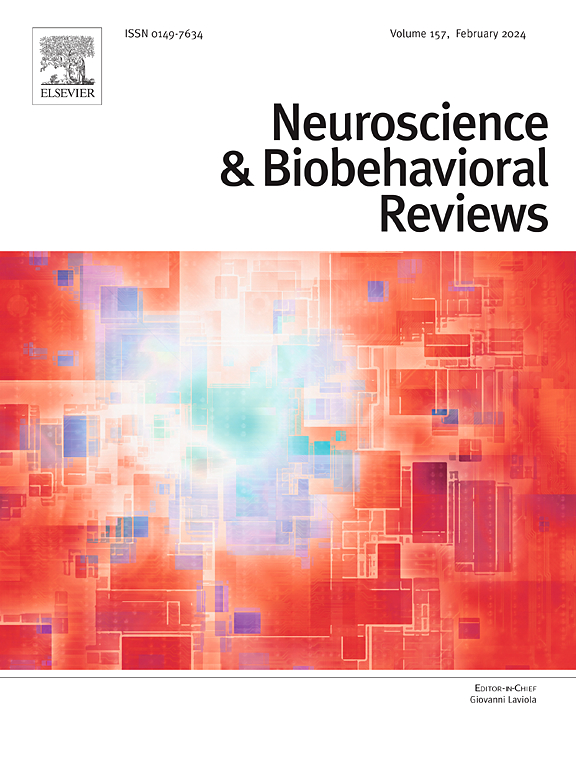Dementia and handedness: Meta-analyses
IF 7.9
1区 医学
Q1 BEHAVIORAL SCIENCES
引用次数: 0
Abstract
Hemispheric asymmetries are a core feature of brain organization and may influence neurodegenerative processes. Handedness has been proposed as a behavioral marker of lateralization, but its relevance in dementia remains unclear. To determine whether individuals with dementia, including Alzheimer’s disease, differ from healthy controls in the prevalence of left-, mixed-, and non-right-handedness (left- and mixed-handedness), frequentist and Bayesian meta-analytic approaches were used. First, a systematic literature search following PRISMA guidelines was conducted in PubMed and Google Scholar through March 2025 using the terms: “((dementia) OR (Alzheimer's disease)) AND (handedness).” Inclusion criteria required studies to (1) report handedness for both dementia and control groups, (2) not match participants for handedness, and (3) provide sufficient statistical data. Eighteen studies (N = 13,282 dementia patients, N = 18,540 controls) met the criteria. Frequentist meta-analyses showed that individuals with dementia were significantly less likely to be non-right-handed (OR = 0.90, 95 % CI: 0.83–0.97, p = 0.01) and mixed-handed (OR = 0.71, 95 % CI: 0.59–0.85, p = 0.01) compared to controls. However, sensitivity analyses excluding the largest study rendered these associations non-significant, indicating limited robustness. Bayesian meta-analyses supported the null hypothesis with moderate-to-strong evidence across all handedness categories (BF₁₀ = 0.06–1.06). Exploratory Bayesian meta-regressions tested dementia subtype as a moderator and revealed no significant effects. In conclusion, while handedness differences in dementia appear small and sensitive to study design, emerging patterns, particularly in mixed-handedness, may reflect subtle disruptions in hemispheric specialization. Further research may clarify whether such traits provide early behavioral signals of neurodegenerative changes.
痴呆和惯用手:荟萃分析
半球不对称是大脑组织的核心特征,可能影响神经退行性过程。偏手性被认为是侧化的行为标志,但其与痴呆的相关性尚不清楚。为了确定包括阿尔茨海默病在内的痴呆症患者在左利手、混合利手和非右利手(左利手和混合利手)的患病率是否与健康对照不同,使用了频率分析和贝叶斯元分析方法。首先,按照PRISMA指南在PubMed和b谷歌Scholar上进行了系统的文献检索,直到2025年3月,使用术语:“(痴呆)或(阿尔茨海默病))和(利手性)。”纳入标准要求研究(1)报告痴呆组和对照组的惯用手性,(2)不匹配参与者的惯用手性,(3)提供足够的统计数据。18项研究(N = 13282例痴呆患者,N = 18540例对照)符合标准。Frequentist荟萃分析显示,与对照组相比,痴呆患者非右撇子(OR = 0.90, 95 % CI: 0.83-0.97, p = 0.01)和混合手(OR = 0.71, 95 % CI: 0.59-0.85, p = 0.01)的可能性显著降低。然而,排除最大研究的敏感性分析显示这些关联不显著,表明鲁棒性有限。贝叶斯荟萃分析用所有惯用手类别(BF₁₀= 0.06-1.06)的中强证据支持原假设。探索性贝叶斯元回归测试了痴呆亚型作为调节因子,但没有发现显著的影响。综上所述,虽然痴呆症患者的惯用手差异似乎很小,而且对研究设计很敏感,但新出现的模式,尤其是混合惯用手,可能反映了大脑半球专业化的微妙破坏。进一步的研究可能会澄清这些特征是否提供了神经退行性变化的早期行为信号。
本文章由计算机程序翻译,如有差异,请以英文原文为准。
求助全文
约1分钟内获得全文
求助全文
来源期刊
CiteScore
14.20
自引率
3.70%
发文量
466
审稿时长
6 months
期刊介绍:
The official journal of the International Behavioral Neuroscience Society publishes original and significant review articles that explore the intersection between neuroscience and the study of psychological processes and behavior. The journal also welcomes articles that primarily focus on psychological processes and behavior, as long as they have relevance to one or more areas of neuroscience.

 求助内容:
求助内容: 应助结果提醒方式:
应助结果提醒方式:


